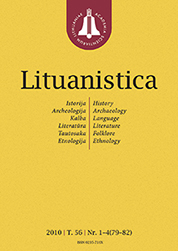LituanisticaWHAT?
 ISSN 0235-716X |
2006 m. Nr. 4 Institucinės santuokos apeigos: socialinės tvarkos įteisinimas Lietuvoje XIX a. II pusėje – XXI a. pradžioje
On the basis of historic, ethnographic literature and ethnographic field research (Church and civil registry office rituals observation, civil registry office staff survey, wedding video recordings) the present article analyzes the role of institutional marriage rituals as a means to set a framework of social order in Lithuania. The results of the investigation of matrimony and civil marriage rituals and a comparison of the structure of the two marriage types show that legally obligatory matrimonial rituals, replaced by civil marriage after World War II, as institutional rituals were quite a formal event in the wedding rituals of village people but eventually got subtly and organically incorporated in the old traditions. Incorporation of wedding symbols (rings and wreaths) into Church and later on into civil marriage rituals was one of the factors that enabled the retention (preservation) of the usage of those symbols in marriage rituals up to present and made the rituals of institutional marriage more acceptable for society, even though in the 7th decade of the 20th century institutional marriage rituals still duplicated the corresponding moments in domestic marriages. Standardized matrimony rituals were analogus to standardized rituals of Soviet civil marriage. The present decade made civil marriage face several changes: it is weakly regulated, and it can be adjusted to the requests of the customer, which means that civil marriage has more freedom to vary and assume regional peculiarities. However, institutional rituals highlighted an increasing opposition between the modern and the folk-ethnic subject matter, as regional peculiarities are not emphasized.
|
Numeriai:
2011 - T.57 Nr.1, Nr.2, Nr.3, Nr.4 2010 - T.56 Nr.1-4 2009 - T.55 Nr.1-2, Nr.3-4 2008 - T.54 Nr.1, Nr.2, Nr.3, Nr.4 2007 - T.53 Nr.1, Nr.2, Nr.3, Nr.4 2006 Nr.1, Nr.2, Nr.3, Nr.4 2005 Nr.1, Nr.2, Nr.3, Nr.4 2004 Nr.1, Nr.2, Nr.3, Nr.4 2003 Nr.1, Nr.2, Nr.3, Nr.4 2002 Nr.1, Nr.2, Nr.3, Nr.4 2001 Nr.1, Nr.2, Nr.3, Nr.4 |